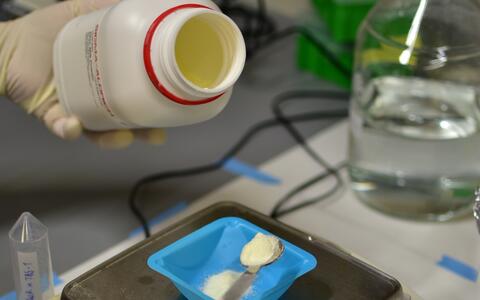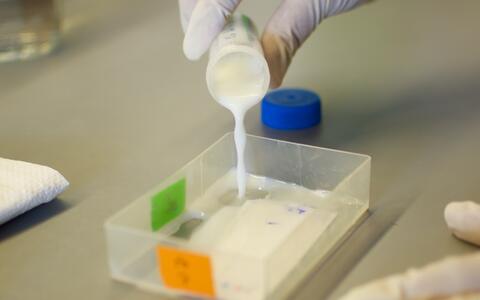#LabHacks: Blocking sticky proteins with milk powder
Ruth is holding a chemical bottle containing milk powder. “We used to just buy it from the supermarket,” she says. Now, her laboratory orders it from the chemical distributors. “This way, no one will be tempted to put it in their coffee!” she adds with a wink.
Ruth Pareja Alcaraz is a technical assistant in the laboratory of MDC researcher Prof. Thomas J. Jentsch. She and colleagues in labs around the world use milk powder to help with a routine task: Finding specific proteins in a “protein jungle” – e.g. a fibrous protein in a cell extract. The molecules are too small to detect under a microscope. It is much more effective to use indirect techniques such as the “western blot.”
How the western blot works
The principle behind the method sounds pretty clever. Ruth begins by sorting the protein species according to their size in a gel, dividing up the molecular ecosystem into small, homogenous “packs”. She then transfers the organized proteins onto a paper-like surface, or membrane, which proteins stick to particularly well – a process known as “blotting” in lab-speak. The membrane is then immersed in a solution of antibodies. Antibodies are proteins that can bind themselves to certain other proteins – a bit like a tracking dog that is trained to hunt only a very specific prey. This particular dog wears a light round its neck – or rather, it contains a special enzyme that can produce light in a chemical reaction. This makes it easy to identify the “protein prey” – a particularly sensitive camera simply records where the sources of light emerge. Wherever there is light, the sought-after protein is present; and where there is more light, there are more proteins.
Skimmed milk powder helps with binding issues
Unfortunately, the antibodies bind in a fairly non-specific way to the membrane onto which the organized proteins have been blotted. Or, to stick with the analogy: the antibody dog bites everywhere – it even bites the “floor.” This causes the entire surface of the membrane to light up and the experiment is ruined.
But this is where skimmed milk powder comes in. The milk proteins contained in the powder stick to the vacant surface area of the membrane and thus prevent the non-specific binding of the antibodies. Skimmed milk powder is particularly good at “blocking” the membrane’s vacant surface area, as its wild mix of very varied proteins provides particularly effective cover. “With strong binding antibodies, milk powder works really well,” says Ruth. “I use a five-percent solution for almost all my blots. With weaker binding antibodies, serum albumin is more suitable. But it really depends on the individual experiment.” Serum albumin is primarily extracted from bovine blood.
There is one clear advantage that albumin has over milk powder: it definitely won’t end up in the coffee!
###
Do you have a lab trick that might surprise fellow researchers? Send us an e-mail!









